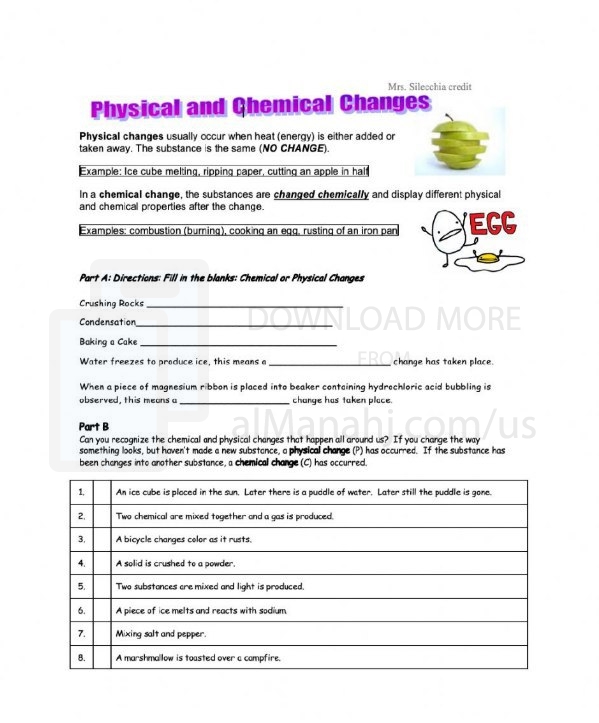| You are here: Almanahj Website ⇒ American curriculum ⇒ 8th Grade ⇒ Physics ⇒ Term 1 | ||
|---|---|---|
Worksheet about Physical and chemical changes | ||
|---|---|---|
| Subject: Physics | ||
| 8th Grade | ||
| Term 1 | ||
| Year: 2023/2024 | ||
| Size: 265.5KB | ||
| Number of clicks: 89 | ||
| Publish date:November 10, 2023 | ||
| Added by: Eman | ||
| Last download date: 2024-09-10 05:06:51 | ||
| Updated by: Eman9966 on 2023-11-10 15:23:01 | By: theodor Monica Angela Caruso | |
| File info: Description Exploring the physical and chemical changes of matter Matter is anything that has mass and takes up space. Matter can undergo various changes, which are classified into two main types: physical changes and chemical changes. Physical changes are changes that do not lead to the formation of a new substance. The material remains in its original state, but its physical properties, such as its shape, size, color, or state, may change. Examples of physical changes: If you cut a sheet of paper, you cause the material to change shape, but the original material (the sheet) is still there. If you dissolve sugar in water, you cause the state of matter to change, but the original substance (sugar and water) is still present. If you heat water, you cause its temperature to change, but the original substance (water) is still there. Chemical changes are changes that lead to the formation of a new substance. The original substance is completely changed, and the resulting substance is different from the original substance in its physical and chemical properties. Examples of chemical changes: If you burn wood, you cause a reaction between the wood and oxygen, which creates a new substance, ash. If you mix an acid with a base, you cause a chemical reaction that produces a new substance, which is salt and water. If you ferment yeast, you cause a chemical reaction that produces a new substance, alcohol. Differences between physical and chemical changes Here are some of the key differences between physical and chemical changes: PropertyPhysical changesChemical changesThe nature of the changeDoes not lead to the formation of a new substanceLeads to the formation of a new substanceState of the original substanceThe substance remains in its original stateThe original substance is completely changedProperties of the resulting substanceSimilar to the properties of the original substanceDifferent from the properties of the original substanceThe possibility of reversing the changeThe change is reversible in many casesThe change is irreversible in most cases Methods for distinguishing between physical and chemical changes There are several methods that can be used to distinguish between physical and chemical changes, including: Observing the formation of a new substance: If a new substance is formed, the change is chemical. Monitoring temperature change: Chemical changes are usually accompanied by a change in temperature. Observing color change: The color of a substance may change during a chemical change. Monitor odor change: The odor of a substance may change during a chemical change. The importance of exploring the physical and chemical changes of matter Exploring the physical and chemical changes of matter is important for understanding the world around us. This knowledge can help us explain natural phenomena, such as the formation of rocks and minerals, life processes, and the interactions of materials with each other. It can also help us develop new technologies, such as drug manufacturing and energy production. | ||
| Downloading link Worksheet about Physical and chemical changes |
|---|
|
1699616297.pdf
The file is being prepared for download
|
| File images |
|---|
 |